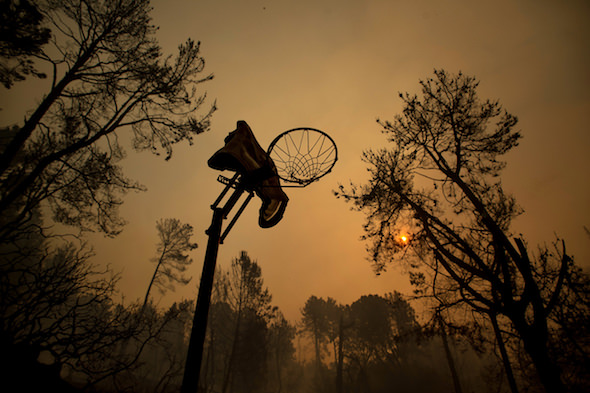Photo of the Week: Wildfires in California
This is what hell might look like.
A melted basketball hoop rests in a clearing after a fire tore through the top of a ridge near Morgan Hill, Calif., on Tuesday. (Noah Berger / AP)
Every week, Truthdig’s editors seek to present an image that singularly renders the world’s triumph, trouble or toil.
What might hell look like? Communities throughout California have an idea. Six major fires consumed 184,000 acres of wildland by the middle of August this year, taking at least eight lives and destroying hundreds of structures in the process.
The headlines begin to tell the story: “Homes burn, thousands flee as out-of-control brush fire chars more than 31,000 acres in Cajon Pass,” “ ‘Very active’ fire at Vandenberg Air Force Base grows to over 10,000 acres; Soberanes fire sets cost record,” “Loma fire destroys one home, triggers evacuations in Santa Cruz mountains.”
The stories point in the direction of misfortune. One tells of Angel Gilberto Garcia-Avalos, a 29-year-old Mexican sentenced to 13 months in prison and ordered to pay $69 million for damages after pleading guilty to starting a fire in the Sequoia National Forest. The Los Angeles Times reports that Garcia-Avalon “was driving off-road illegally Aug. 16 when his Nissan Maxima got stuck on a berm and his catalytic converter and muffler ignited dead grass.”
Another tells of two bear cubs who sparked a brush fire when they were electrocuted after climbing a power pole. Their mother dragged them away from onrushing firefighters. A third highlights the threat to California’s cultural inheritance. For several days in late August, authorities guarded Hearst Castle, a national historic landmark that served as a residence for newspaper magnate William Randolph Hearst and an inspiration for Orson Welles’ film classic “Citizen Kane.”
Talk of drought turned from water to labor in mid-September when California began to run out of prison inmates it can legally impress to fight the blazes.
“We’ve just had to scramble harder to find inmates we can get,” said Bill Sessa, spokesman for the California Department of Corrections and Rehabilitation. “We still have to be selective about the inmates we choose.” Reports say inmates are paid $1 to $4 an hour, while others are paid the state’s minimum wage of $9. The state began employing inmates in this way in the 1940s. Traditionally, they have accounted for at least 20 percent of the state’s wildfire fighting force. They hold hoses and dig containment lines, among other duties. Officials are concerned that a new law mandating that the state move inmates imprisoned for non-serious, nonviolent and non-sexual offenses to county jails would reduce the number they can use to fight fires.
As of Saturday, most of the listed fires that began during the spring and summer were contained. Five in as many counties are still considered active.
Increasing numbers of fires can be expected in years to come as rising global temperatures increase drought in some regions.
Independent journalism is under threat and overshadowed by heavily funded mainstream media.
You can help level the playing field. Become a member.
Your tax-deductible contribution keeps us digging beneath the headlines to give you thought-provoking, investigative reporting and analysis that unearths what's really happening- without compromise.
Give today to support our courageous, independent journalists.






You need to be a supporter to comment.
There are currently no responses to this article.
Be the first to respond.